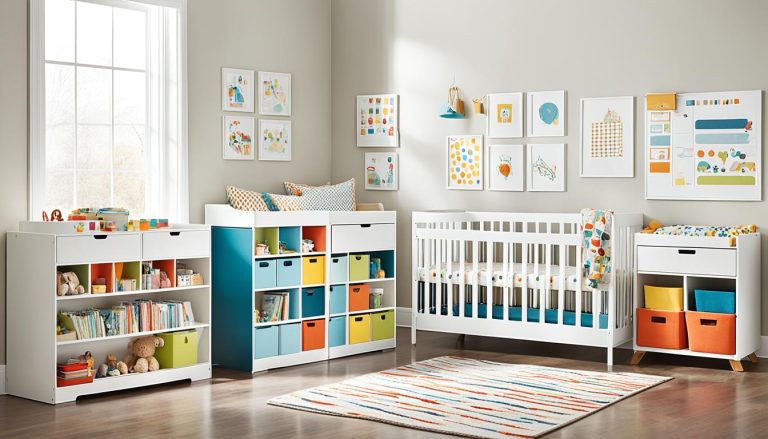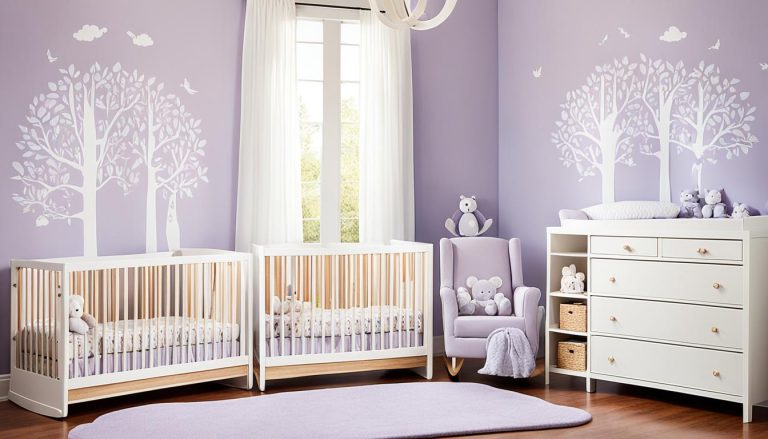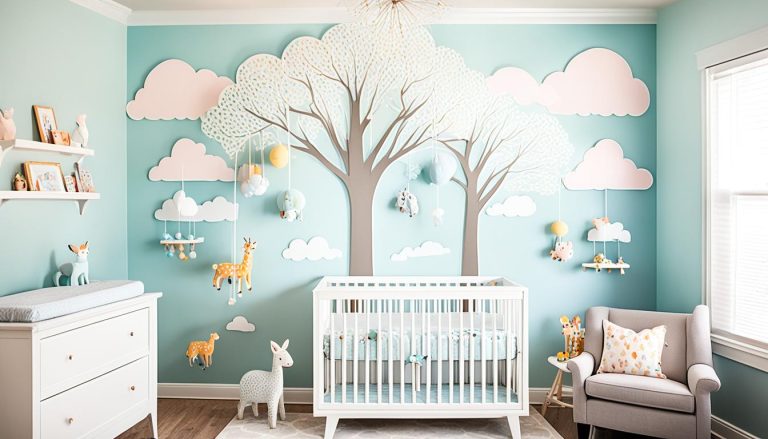Babyproofing Your Nursery: Safety First Guide
houseremodelingnews.com may earn a commission if you purchase a product through one of our links
“The greatest legacy we can leave our children is happy memories.” – Og Mandino
Starting with babyproofing your nursery is key to creating a safe space for your baby. As you get ready for your little one’s arrival, putting safety first is crucial. Did you know 60% of parents look for safety features when picking a crib? This guide will show you how to make your nursery safe for your baby.
Preventing injuries starts with spotting potential dangers at home. We’ll talk about everything from crib safety to window guards. Babyproofing is a continuous effort. As your baby grows, so do the risks.
Let’s work together to make a safe place for your baby to grow. With the right knowledge and tools, you can reduce risks and increase peace of mind. Are you ready to start this journey of love and protection? Let’s begin!
Understanding the Importance of Nursery Safety
Creating a safe space for your baby is key in infant care. Childproofing your nursery stops accidents and eases your mind. Did you know a new nursery product recall happens every two weeks in the U.S.? Also, up to 80% of recalled children’s items stay in homes after the recall.
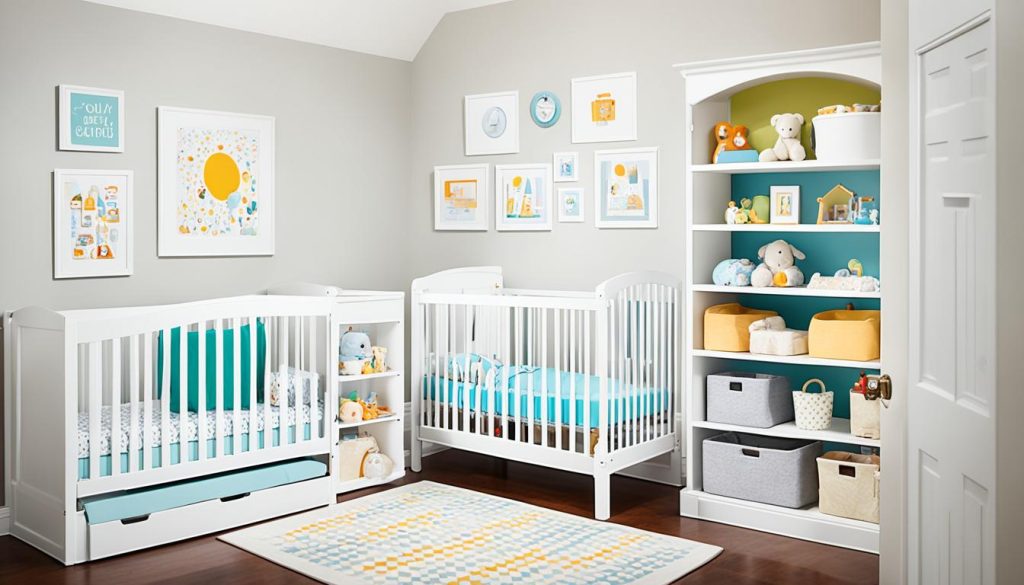
Preventing accidents starts with being aware. As your baby grows, they become more curious. Around 5 months, they start crawling, showing it’s time to take toys out of the crib. This is when a safe space becomes crucial.
Experts often talk about sleep safety. The American Academy of Pediatrics suggests babies sleep on their backs on a firm surface to lower the risk of death. For the first six months, your baby should have their own sleeping area in a crib or bassinet.
- Secure furniture to walls to prevent tip-overs
- Install window stops to limit openings to 4 inches
- Place bassinets and car seats on the floor, not elevated surfaces
- Add bumpers to sharp furniture corners
As your child grows, so does the need for safety updates. Regular checks and changes in childproofing keep your little one safe.
Safety First: Babyproofing Your Nursery
Creating a safe nursery is a top priority for new parents. A well-designed, baby-friendly space can prevent accidents and give you peace of mind. Let’s explore why safety should be the cornerstone of your nursery design and how to create a comprehensive babyproofing plan.
The Importance of Safety in Nursery Design
Nursery design is more than just looks. It’s about making a secure space for your baby. Falls, hitting objects, and poisoning are the top reasons young kids end up in the ER. This shows how important childproofing is.
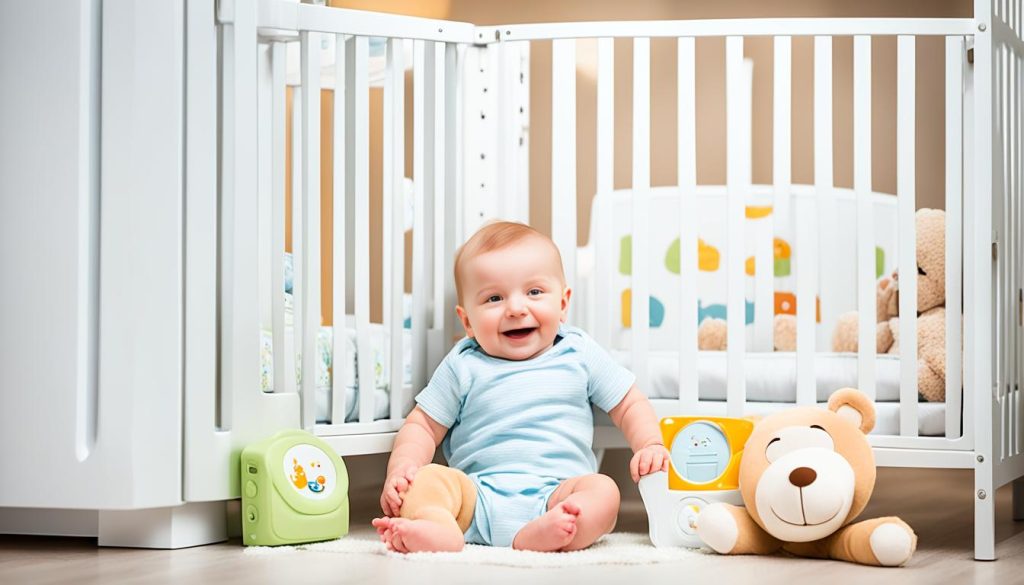
Common Nursery Hazards
Removing hazards is crucial for a safe nursery. Watch out for:
- Unsecured furniture that could tip over
- Window cords that could strangle your baby
- Exposed electrical outlets
- Small objects that could be choking hazards
Creating Your Babyproofing Plan
Begin babyproofing at least three months before your baby arrives. This gives you enough time to tackle all safety issues. Think about getting a childproofing kit. For instance, the Home Safeguarding Set by Safety 1st has 80 key items like plug protectors, door knob covers, and cabinet locks.
Preventing SIDS is also key. Make sure your crib meets safety standards and don’t use soft bedding. Update your childproofing as your baby grows. With these tips, you’re on your way to a safe, caring space for your baby.
Essential Safety Features for Your Baby’s Crib
Your baby’s crib is key to nursery safety. Picking the right crib and setting it up right are vital for SIDS prevention and baby equipment safety. Let’s look at the main features that make a crib safe for your baby.
Crib Safety Regulations and Standards
When looking for a crib, choose ones made after June 2011. These cribs meet the latest safety standards, preventing falls and entrapments. Make sure the crib slats are no more than 2 3/8 inches apart to avoid head entrapment risks. Go for cribs with JPMA or ASTM certification for the highest safety level.

Proper Mattress Fit and Firmness
A firm mattress is crucial for crib safety. Pick a mattress made just for cribs, no thicker than six inches. It should fit well in the crib frame, leaving no more than two fingers’ width between the mattress and crib sides. Think about a Greenguard Gold certified mattress for low volatile organic compound emissions.
Avoiding Crib Accessories and Soft Bedding
Keep the crib free of accessories and soft bedding for nursery products safety. Bumper pads, pillows, and stuffed toys can cause suffocation. Use a fitted sheet on the mattress and dress your baby warmly. A bare crib is the safest choice.
“A safe sleep environment is key to reducing the risk of SIDS and other sleep-related infant deaths.”
By following these guidelines, you’re taking crucial steps towards a safe sleep space for your baby. Always keep up with the latest crib safety advice to make sure your nursery stays a safe place for your little one.
Securing Furniture and Preventing Tip-Overs

Creating a safe space for babies starts with securing furniture. It’s key to tie down heavy items like dressers and bookshelves to walls. This is vital for preventing falls. Sadly, furniture tipping can lead to serious injuries or even death, especially for curious toddlers.
When setting up your nursery, keep these safety tips in mind:
- Use the right hardware to anchor furniture to walls
- Avoid furniture with glass doors in the nursery
- Install childproof locks on drawers to stop climbing
- Choose furniture with rounded edges or add corner protectors
- Keep heavy items on lower shelves
Starting with babyproofing early is crucial. As babies grow and become more curious, these safety steps become even more vital.
“Safety doesn’t happen by accident. It’s a choice we make every day.”
To make your nursery as safe as possible, keep furniture away from windows. This helps stop toddlers from climbing and falling. By following these steps, you’re making a big difference in your baby’s safety and well-being.
Window Safety: Preventing Falls and Strangulation Hazards
Your baby’s nursery should be a safe place. Window safety is key to keeping your little one safe. Every year, over 5,000 kids end up in the emergency room from window falls. Let’s look at how to make your nursery windows safer.
Installing Window Guards and Stops
Window guards are a strong defense against falls. They let in air but keep toddlers safe. Window stops also limit how far a window can open, adding more safety. But remember, screens can’t stop falls alone!
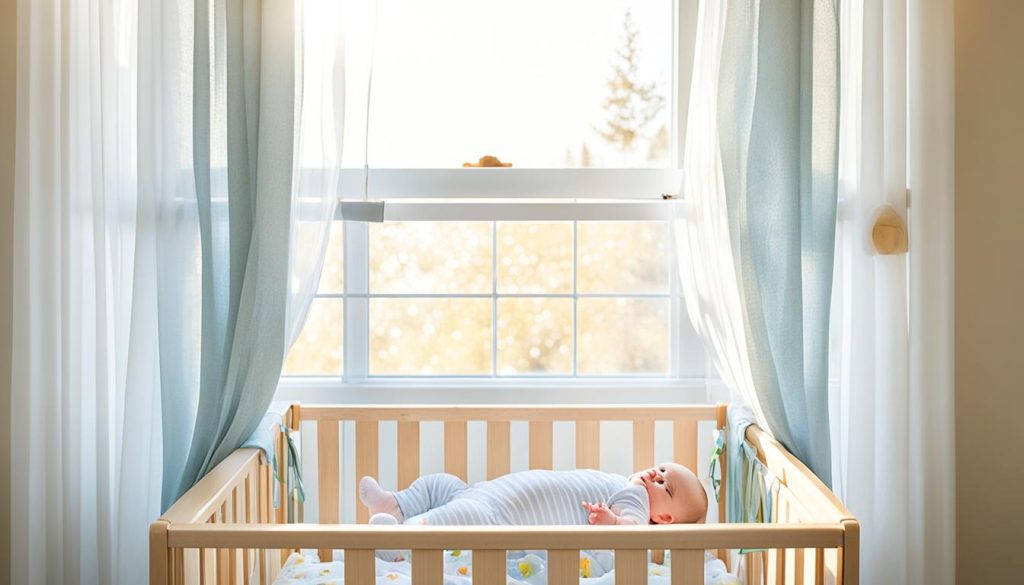
Cord Safety for Blinds and Curtains
Cords from blinds and curtains can be dangerous. Choose cordless options or secure cords with safety devices. The Consumer Product Safety Commission made cordless window coverings mandatory by 2018 because of the risks they reduce.
Positioning Furniture Away from Windows
Keep cribs, beds, and other furniture away from windows. This stops climbing and lowers fall risks. It’s an important step in keeping your nursery safe.
By focusing on these window safety tips, you’re making your nursery safer. Regularly check and update your safety steps as your baby grows. This ensures your little one stays protected from nursery hazards.
Electrical Safety in the Nursery
Making a safe space for your baby means dealing with electrical safety. Babies are curious and can easily get into dangerous situations if not protected.
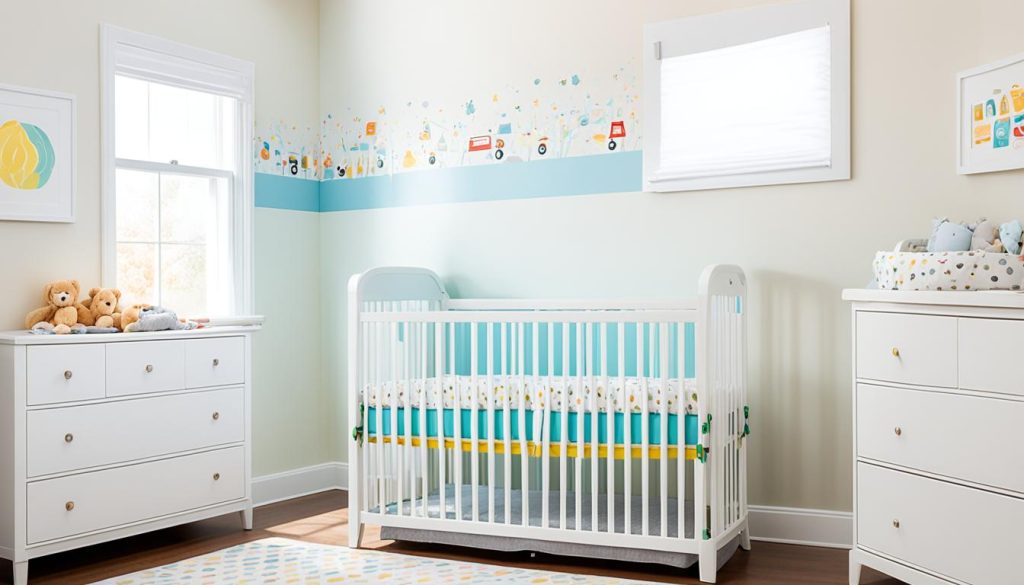
First, cover all electrical outlets with safety plugs or sliding covers. This easy step stops potential shocks. Just a second can be all it takes for a baby to stick something in an outlet.
Next, keep cords tight and at least 3 feet from the crib. Use cord shorteners to manage extra length. This stops strangulation risks and keeps cords away from your baby.
- Avoid using extension cords in the nursery
- Install tamper-resistant outlets for extra protection
- Regularly inspect electrical cords for damage
- Keep electrical appliances out of reach and unplugged when not in use
Did you know that child accidents are the leading cause of death in kids aged 0-12? By following these electrical safety steps, you’re greatly lowering risks in your baby’s area.
Safety isn’t expensive, it’s priceless when it comes to your little one.
Creating a safe nursery is an ongoing task. As your baby moves and grows, you’ll need to check and update your safety steps often.
Childproofing Dresser Drawers and Closets
Keeping your little one safe is a top priority. It’s important to childproof your nursery’s storage areas for baby accident prevention. Let’s look at some effective tips for dresser drawers and closets to make a safe space for your baby.
Installing Drawer Locks and Closet Latches
Use childproof locks on your dresser drawers and closet doors. The Vmaisi Magnetic Locks are a good choice, costing $45 for 20 locks. For closets, the Heoath Baby Proofing Latches at $13 are stylish and work well.
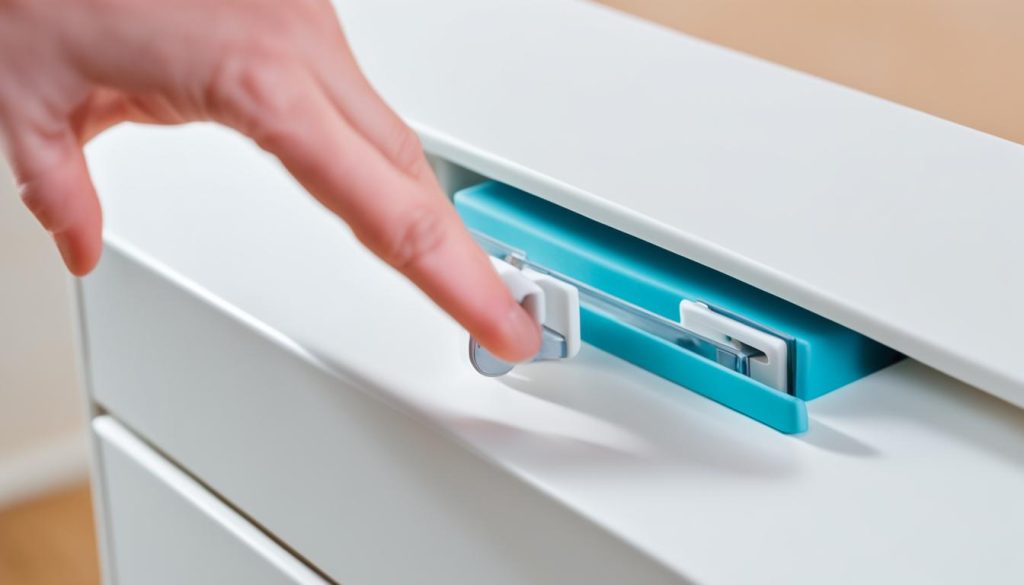
Organizing Nursery Items Safely
Organizing your nursery safely is crucial. Keep dangerous items out of reach and easy-to-use items within reach. Use open bins for toys instead of boxes with lids. This makes your home safer and easier to manage.
Preventing Pinched Fingers
Keep little fingers safe from getting caught in doors. Add finger-pinch guards to door hinges, especially for closet doors. You might also think about using curtains instead of doors for easier access and less injury risk.
“Regular reassessment of childproofing measures is advised as the child grows and habits change.”
Childproofing is an ongoing task. As your baby grows, check and update your safety steps. With these tips, you’ll make your nursery safer, giving you peace of mind as your baby explores.
Safe Storage Solutions for Nursery Essentials
Creating a safe nursery means choosing smart storage solutions. It’s important to make sure your baby’s room is both safe and functional. Let’s look at some ideas for organizing the nursery safely and conveniently.

First, pick furniture with rounded edges to avoid injuries. Choose dressers with locks to keep your baby’s hands out. Put things like medications and cleaning supplies in high shelves or locked cabinets.
For toys, think about using storage bins or chests without lids or with spring-loaded hinges. This stops your baby from getting hurt by pinching or trapping. Put small items in drawer dividers or clear containers to keep them from getting lost or causing choking.
- Use floating shelves for books and decorations
- Install wall hooks for hanging bags and clothes
- Put extra bedding in under-crib storage
- Use closet organizers for clothes
Organizing your nursery is an ongoing task. Check your storage often as your baby grows. This keeps your nursery safe and free from clutter for your baby.
“A well-organized nursery is a safe nursery. Every storage decision should prioritize your baby’s safety and your convenience.”
By using these safe storage ideas, you’ll make a nursery that’s both useful and safe. Your peace of mind is worth the effort of organizing your nursery well and keeping it free from hazards.
Choosing and Positioning Baby Monitors
Baby monitors are key to keeping your baby safe and cared for. When picking one, look for features that make you feel secure.
Key Features for Baby Monitors
Choose monitors with clear audio, a strong signal, and video. Some have temperature sensors and let you talk back, adding more security to your baby’s space.
Optimal Placement for Safety
Place your baby monitor at least 3 feet from the crib. This stops cords from getting tangled, a big safety issue. For wall-mounted ones, tie cords high up to keep them away from your baby.
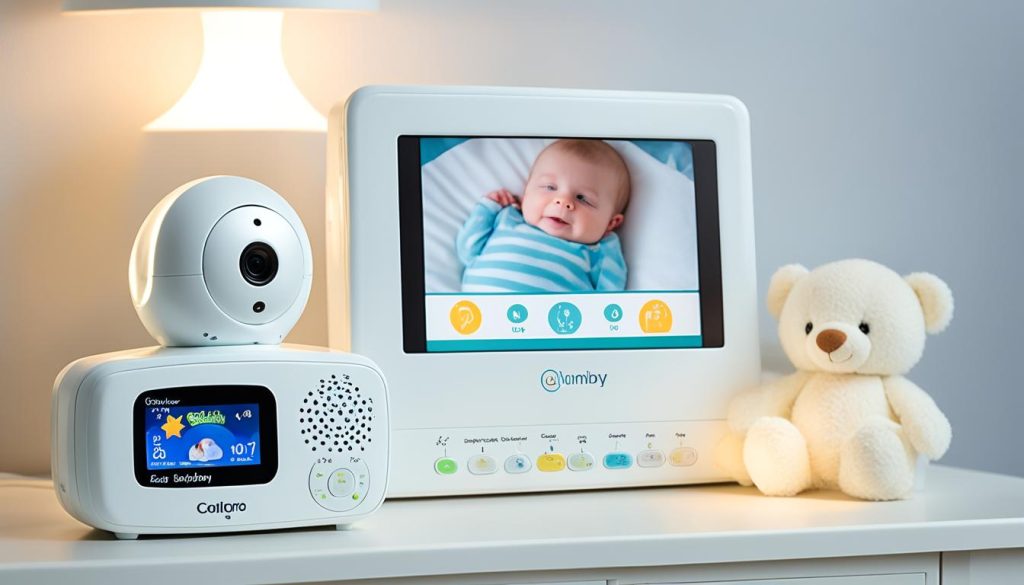
Cord Management Tips
Keeping cords safe is crucial. Use covers or clips to tie cords to the wall, keeping them away from your baby. This simple action helps avoid strangulation risks and makes sleeping safer.
- Regularly test your monitor’s functionality
- Keep backup batteries on hand
- Secure your Wi-Fi network if using internet-connected monitors
Even with baby monitors, adult supervision is always best. Use technology wisely, but always be there for your baby.
Nursery Lighting and Temperature Control
Creating a safe space for your baby starts with the right lighting and temperature. Soft, adjustable lights help make the room calm. Use nightlights for easy walking during late-night feedings. Make sure lamps are away from the crib and don’t have tablecloths that babies might pull down.
Keeping the nursery at a steady temperature is key to preventing Sudden Infant Death Syndrome (SIDS). Aim for a temperature of 68-72°F (20-22°C). Use a room thermometer to check the temperature. Blackout curtains can help control light and temperature, making it easier for your baby to sleep.
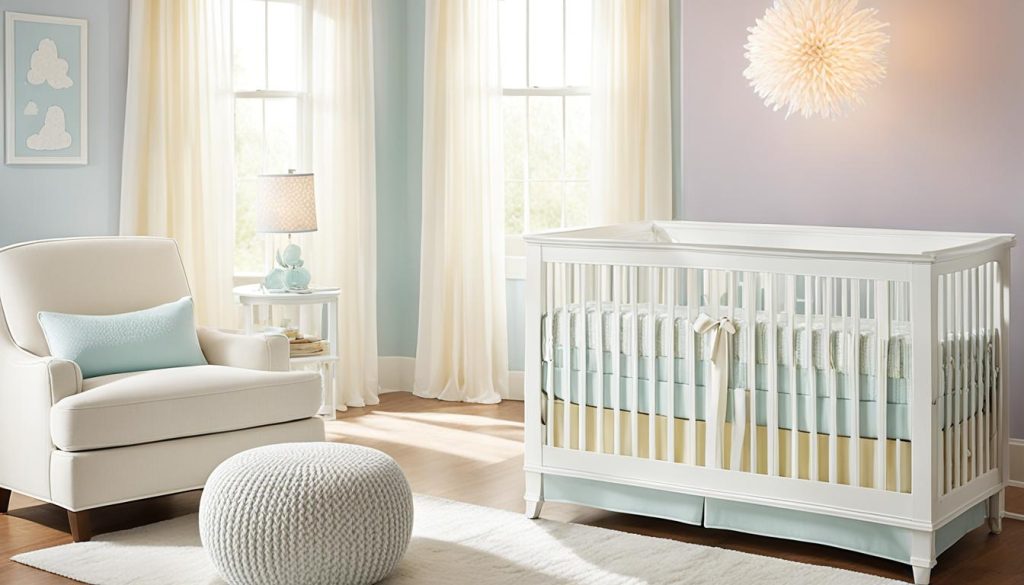
- Programmable nightlights with dimming capabilities
- Smart thermostats for precise temperature control
- Baby monitors with room condition tracking
Make sure heating and cooling vents are clear of furniture or curtains. This ensures good air flow, making the room safe and comfy for your baby.
“A well-designed nursery considers both comfort and safety, creating the perfect haven for your baby’s growth and development.”
By paying attention to lighting and temperature, you’re making your nursery safe and cozy for your baby.
Creating a Safe Play Area Within the Nursery
A safe play area in your nursery is key for your baby’s growth and your peace of mind. Studies show that babies in secure spaces play more, 70% more, than those in risky areas. This leads to better motor and thinking skills, a 50% boost.
Selecting age-appropriate toys
Pick toys that fit your baby’s age. For 4-6 month olds, soft fabric blocks and activity centers are perfect. As your child gets older, change out toys to keep things interesting. Always check toys for damage and take out any broken ones to avoid accidents.

Proper toy storage to prevent tripping hazards
Keeping the nursery tidy helps prevent accidents. Use open shelves or soft baskets for toys. This keeps things easy to reach and cuts down on tripping risks. A toy box that holds up to 275 lbs is a good choice for the long run.
Using play mats and soft surfaces
Make a soft play area with foam tiles or play mats. These make a soft spot for your baby and can cut injury risks by 40%. For extra comfort, add floor cushions around the play area.
With these safety steps, you’re making a safe spot for your baby to grow. A well-thought-out play space is good for your family for years, with 65% of parents seeing long-term benefits.
Installing and Using Baby Gates
Baby gates are key to keeping your little one safe. They block off areas that could be harmful. Make sure to pick gates that are strong and up to the latest safety rules.
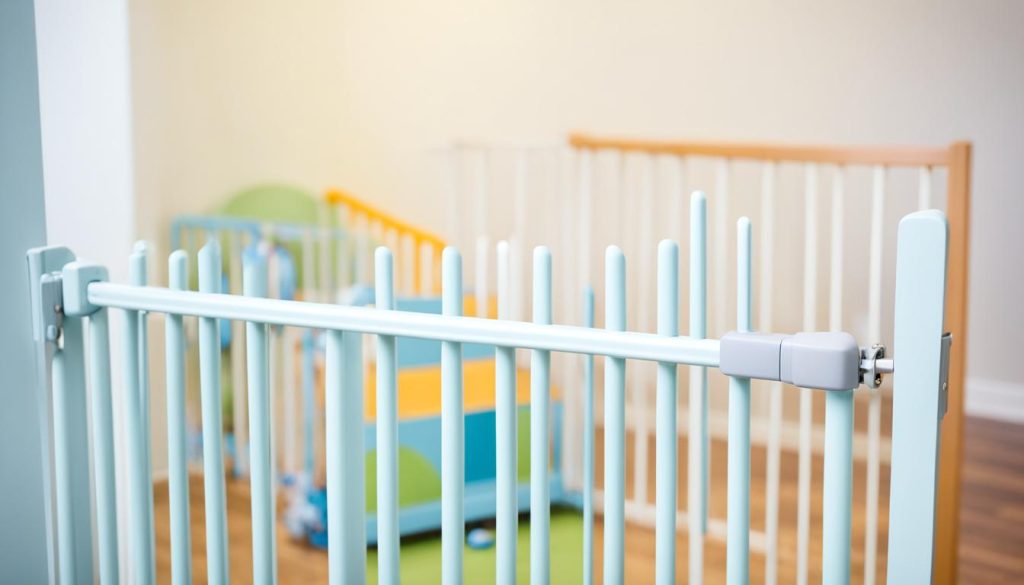
For stairs, go for gates that are screwed into the wall at the top and bottom. Gates that you push against the door are okay for doorways but not stairs. Always measure your area before buying to make sure the gate fits right.
- Choose heavy-duty gates with complex latches
- Install retractable gates at the bottom of staircases
- Use magnetic or traditional cabinet locks for added security
It’s important to check your gates often. Make sure they’re tightly fastened and close well. As your child gets taller, you might need to change how you keep things safe. Take down the gates when your child can climb over them or doesn’t need them anymore.
“Safety gates are a must-have for homes with stairs. They significantly reduce the risk of falls, which are a leading cause of injuries in young children.”
While baby gates are great, they’re just part of keeping your child safe. Use them with other safety steps like tying down furniture and covering outlets. This way, you’ll make a safe space for your little one.
Addressing Potential Choking Hazards
Making a safe space for your baby means getting rid of choking hazards. Your nursery should be a place without dangers that could hurt your little one.
Identifying Small Objects and Choking Risks
Look around your nursery for small things that could be choking hazards. Coins, batteries, and tiny toy parts are often dangerous. Use the “toilet paper roll test” to check if something is a choking risk. If it goes through a roll, it’s a danger.
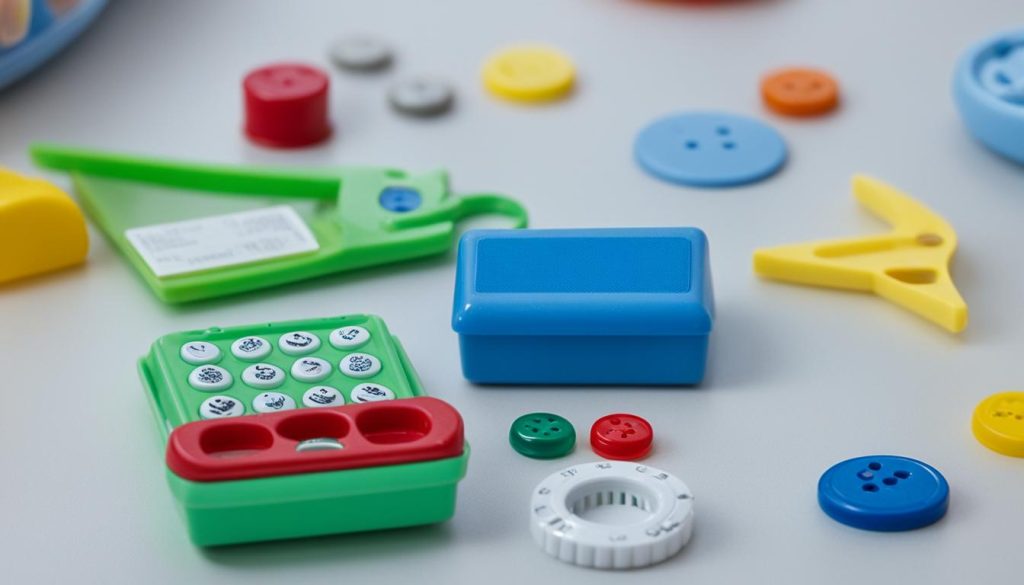
Safe Storage of Small Items
Keep small things away from your baby. Use sealed containers to store them safely. This keeps your baby safe and lowers the risk of nursery hazards.
Choosing Age-Appropriate Decorations
Pick decorations without small parts that can come off. Watch out for window blind cords, clothing strings, and long mobiles. These can be dangerous for your baby.
- Keep dangerous items like button batteries locked away
- Avoid decorations with small, removable pieces
- Secure or remove long cords from blinds and curtains
Keeping your baby safe is an ongoing job. As your child grows, check your nursery often to make sure it’s still safe for them.
“Safety is not a gadget but a state of mind.” – Eleanor Everet
Maintaining Air Quality in the Nursery
Creating a safe space for your baby starts with clean air. Your baby’s lungs need air free from pollutants. Let’s look at how to keep the nursery air clean and fresh.

First, make sure the nursery is well-ventilated. Open windows often to let in fresh air. This simple action can greatly improve the air quality inside.
Also, choose non-toxic materials for decorating. Pick paints and finishes labeled as low-VOC or zero-VOC. These options cut down on harmful chemicals, making a healthier space for your baby.
- Keep the nursery smoke-free
- Avoid using air fresheners or scented products
- Clean and vacuum regularly to reduce dust and allergens
- Monitor humidity levels (aim for 40%)
Good air quality helps prevent SIDS. A well-ventilated room lowers the risk of overheating, a SIDS risk factor. Always put your baby to sleep on their back in a firm crib with no soft bedding.
Remember, a clean nursery is a safe nursery. Regular cleaning and proper air flow are essential for your baby’s health and comfort.
By focusing on air quality, you’re making a big step towards a safe and nurturing space for your baby to grow and thrive.
Regular Safety Checks and Maintenance
Keeping your nursery safe is an ongoing task. A detailed nursery checklist helps avoid accidents and keeps your baby’s area secure as they grow. Let’s look at how to keep your little one’s space safe.
Creating a Nursery Safety Checklist
A detailed nursery checklist is essential for preventing baby accidents. Make sure to include these items:
- Check crib hardware monthly
- Inspect window guards and stops
- Test smoke and carbon monoxide detectors
- Examine furniture stability
- Review toy safety and age-appropriateness
Performing Routine Inspections
Regular safety checks are a must. Every week, go through your nursery for potential dangers. Look for loose cords, unstable furniture, or small items that could be choking hazards. This careful check is key to keeping your child safe.
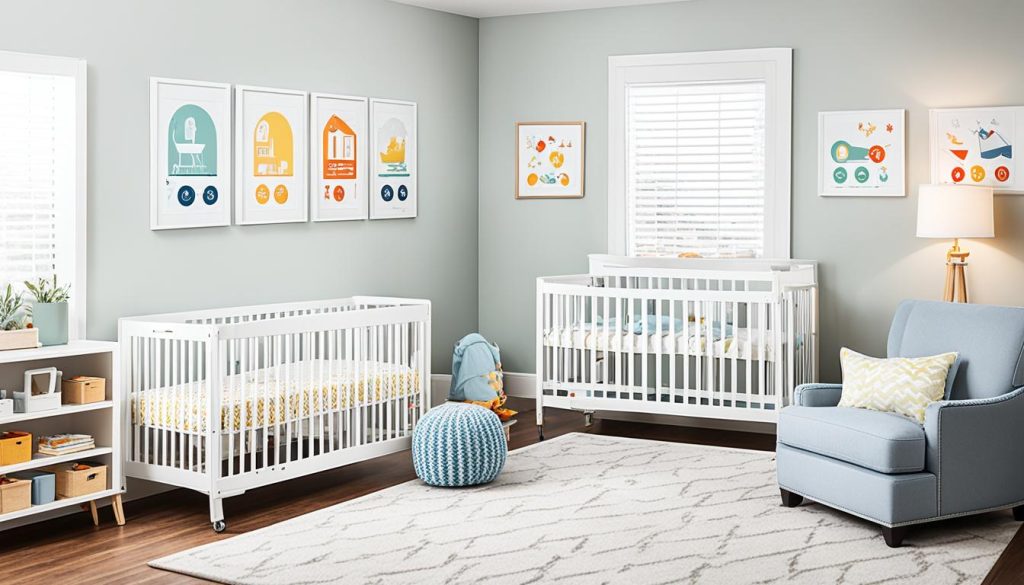
Updating Safety Measures as Your Baby Grows
As your baby grows, so should your safety plan. Review your nursery setup every few months. Update your childproofing to fit your child’s new abilities. For instance, when your baby starts crawling, secure low cabinets and cover electrical outlets.
“Safety first isn’t just a saying; it’s a mindset that protects your child every day.”
Staying updated on product recalls and safety news is part of keeping your nursery safe. By following these tips, you’re making a secure place for your baby to grow and explore safely.
Closing Thoughts
Making a safe space for your baby is very important for parents. Babyproofing your nursery is more than just checking off a list. It’s an ongoing effort that needs constant attention. The numbers show us that keeping your nursery safe is key.
With over 65,000 young kids treated for nursery injuries in 2015, it’s clear that parents have a big role in keeping them safe. By being careful and proactive, you can help prevent these accidents.
Remember, babyproofing is not just a one-time job. As your baby starts moving around, you’ll need to check and change your safety steps. For example, when your baby crawls, make sure to tie down furniture and use safety latches on drawers.
Also, think about the dangers of things like window coverings. The Consumer Product Safety Commission suggests cordless options to avoid accidents.
Even with a well-babyproofed nursery, watching your child closely is still crucial. Keep up with the latest safety rules and recalls. For instance, cribs made before 2011 might not be safe anymore. By focusing on safety and keeping up with new info, you’re making a safe place for your baby to grow and explore.



